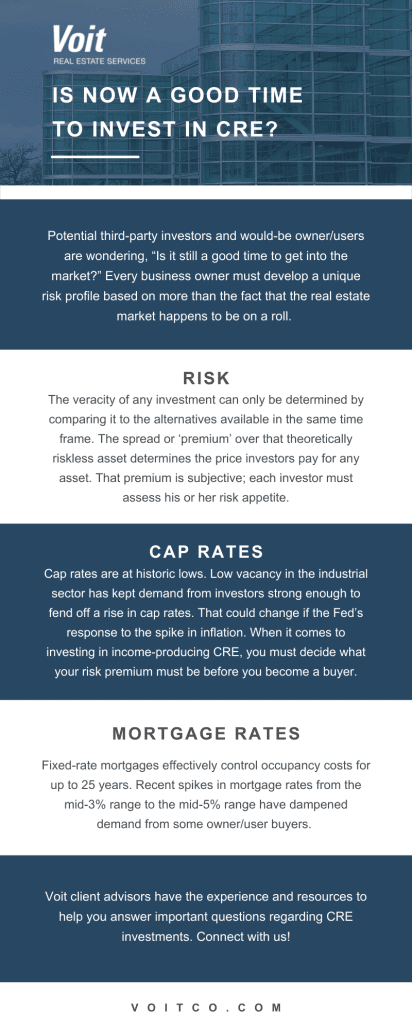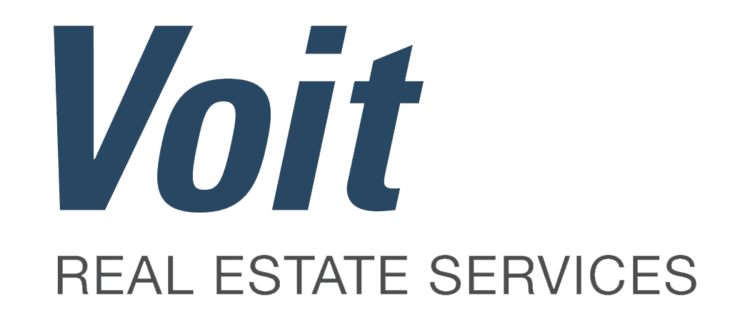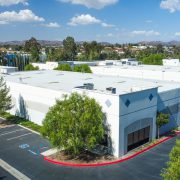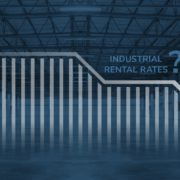Investing in CRE: Is Now a Good Time?
The demand for industrial real estate in San Diego is still running high. This demand has many of our clients asking us about the sustainability of the run-up in property values that has sent pricing far above the previous cyclical peak back in 2007.
Potential third-party investors and would-be owner/users are wondering, “Is it still a good time to get into the market?” The answer depends on several variables.
Let’s take a look at a few of them to shed some light on what might be best for you in the long run.

What to Consider Before Investing in Commercial Real Estate
Risk
First, the veracity of any investment can only be determined by comparing it to the alternatives available in the same time frame.
If the yield on a ‘no-risk’ 10-year U.S. treasury bill (T-bill) is 2.8%, as it is today, it makes little sense to invest in real estate that returns just 3%, but carries with it considerable risk.
The spread or ‘premium’ over that theoretically riskless asset is what determines the price investors will pay for any particular asset. That premium is subjective and each investor must assess his or her appetite for risk.
Cap Rates
Cap rates are still at historic lows, while the 10-year Treasury yield has more than doubled since last October 2021. That puts pressure on cap rates to rise to maintain a spread that reflects the level of risk of real estate ownership.
An increase in the cap rate causes a corresponding decrease in price. So far, low vacancy in the industrial sector has kept demand from investors strong enough to fend off a rise in cap rates.
However, that could change—especially if the Fed’s response to the spike in inflation slows the economy more than desired.
When it comes to investing in income-producing commercial real estate, you must decide what your risk premium must be before you become a buyer.
Mortgage Rates
For the most aggressive owner/user buyers, the risk of a price bubble is offset by historically low mortgage rates.
Fixed-rate mortgages effectively control occupancy costs for up to 25 years, mitigating the risk of a price correction for business owners who believe they can use the same facility for five to 10 years.
That long-term perspective emboldens them to pay a record price for a building that suits their needs. However, the recent spike in mortgage rates from the mid-3% range to the mid-5% range has begun to dampen demand from some owner/user buyers.
Since the rate hikes are recent, it is too early to tell just how much current demand goes away in the coming months.
Everyone’s Circumstances Are Different
For some, things have gotten just a bit too scary, and they opt for the flexibility that comes with leasing.
They are either:
- More risk-averse, or
- They see the potential risk of being stuck in a building during a market correction that does not suit rapidly changing space needs
The point is: Every business owner must develop a unique risk profile that is based on more than the fact that the real estate market happens to be on a roll.
Rather, it has to be built on multiple variables specific to each owner’s unique circumstances, in addition to real estate market conditions.
Finding Quality Commercial Real Estate
Right now, whether you are looking to buy or lease the next home for your industrial business, it is difficult to find quality space. The vacancy rate in San Diego has fallen to just 2.1% and it is still trending lower.
The lack of new development only compounds the problem, and that allows landlords to negotiate longer-term leases with higher annual rent increases.
Thus, more tenants are looking to buy, as the flexibility associated with leasing is compromised by being forced to lease for a longer-term. Also, lease rates have risen along with sales prices, so business owners are stuck with higher occupancy costs whether they buy or lease.
Like every other business owner, you will be facing a real estate decision in the not-so-distant future.
- Which way will you go?
- What will you have to choose from when the time comes?
- How much will it cost?
- Most importantly, what can you do now to prepare yourself to choose wisely?
Voit client advisors have the experience and resources to help you answer those important questions. All it takes is a phone call to get things started. We look forward to hearing from you.
For those who are interested in learning more about our team of client advisors, read on in our article “What’s the Difference Between a Broker and a Client Advisor?”









